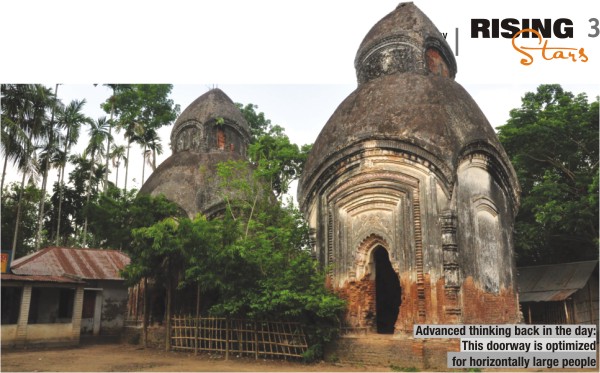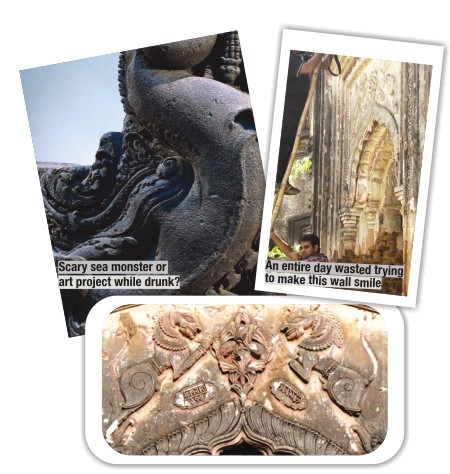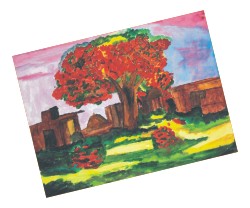

The Legend of the Makara
By Adnan M. S. Fakir
Near the town of Jessore, there is a suburb called Chanchra and in there lies a Jora Shiv Temple at Murali in an almost dilapidated condition. That temple is a tiny treasure trove of mythological creatures that spawn primarily from the Hindu mythology, preserved magnificently over the ages.
Constructed in 1782 by a Chanchra Raja, there are two almost identical Shiv temples in the location (Jora, meaning a pair); not that impressive. However, what is impressive is what lies on the doorway of the first temple; the arch of the doorway is engraved with the head of a mythical creature; its head shaped like an elephant and teeth like that of a crocodile. Two heads are positioned in symmetry above two ends of the archway and jumping from the two heads are two lions in leap towards a fruit tree, their mouths perched open with a fruit clasped in their teeth. Above lie a row of images of humans and one fruit, with the two heads of the mythical creature at two ends of the row as if engulfing the humans.
 The Sea Monster
The Sea Monster
This was the first temple I encountered in Bangladesh decorated solely based on creature mythology. The elephant head with teeth of a crocodile was undoubtedly that of a Makara. Locals address it as the Mokkor and claim it to be a sea monster still lurking in the waters of our part of the world - our very own Loch Ness monster you may say - and some even claimed that their forefathers had seen it.
The Makara has appeared in Indian and Buddhist art from ancient times: on temple pots, on rare pre-Kusana (1st century AD, in the region that is now Afghanistan) coins, on temple walls, as sculptured waterspout. The Makara is usually regarded as an emblem of the waters, the plants and as the vehicle of the River Goddess Ganga and the Sea God Varuna. Yet, interestingly, its acknowledged prototype is the crocodile, an animal that, from the beginnings of Indian civilisation, has been an object of fear and a symbol of the unknown sea. More intriguingly, the symbol sprouts on Shiv temples all over South Asia. The key lies in the Makara taking the form of a crocodile.
The Jora Shiv Temple is certainly not the only place in Bangladesh where the Makara symbol has appeared. It can also be found in a sculpture in Sonargaon, (which was once a Hindu settlement), on a single remaining terracotta plaque at the Khodla Moth in Ajodhya at Bagerhat, and also at the Rayerkathi Temple Complex at Pirojpur.
Origin and Significance
The animal may have first appeared on an Indus Valley seal of a boat sharply upturned at both ends, with a Makara-like figure at the prow. Note that the Indus Valley civilisation dates as far as 3,300 BC meaning that the legend of the Makara is very, very old. Note “very”.
By Buddha's time, Indian sailors had travelled great distances across the sea, reaching as far as Malaya and Indonesia. But fear of such journeys and the unknown always remained, and from fear stemmed the significance of the Makara and its body being partly shaped like that of a crocodile; crocodile because crocs were responsible for the destruction of many voyager boats in the olden days. The Cullavagga (one of the sacred scriptures of Buddhism, 4th century B C) speaks of the Makara as “great ocean creatures that… stretch from one to five hundred leagues.” Okay, perhaps the makara could give Nessie a serious run for her money.
In other words, Shiv being the God of Destruction is perfectly suited for the Makara. The impressive portion is how the Makara symbolism has sprouted all over history - from coins in Mohenjo Daro in 200 BC to the Jora Shiv Temple 1782 AD. Interestingly, the lion that appears in the Jora Shiv Temple also appears in many other places where the Makara is positioned. So, what is the story of the lion?
The Story of the Lion
As the tale goes, when Shiv, was about to wed Parvati, a messenger named Rahu came to him from the land of demons. The message he brought was that the Demon Lord considered Shiv unworthy to wed Parvati, and that he himself would take her instead.
Shiv became so angry that a monster in the shape of a man-lion sprang out from between his eyes and fell upon the unfortunate Rahu. Rahu threw himself at Shiv's feet and begged for mercy. Shiv agreed to let him go but the lion that was born of his wrath complained of hunger.
“You created me to devour the demon,” he protested. “And now you have forgiven him and sent him away. What am I to do?”
“If you have been cheated of one demon,” replied Shiv, “there is still another. You will just have to eat yourself.”
And this the monster did. He began with his legs and then his arms, gradually eating himself up until nothing remained of him but the face. The sight so amused Shiv that he appointed the lion spirit - or what remained of it - as the guardian of his door, to be worshiped and fed by all who entered.
Be it simply in legends through the Makara or in reality through the crocodiles, the symbol has been immortalised in man's history and it is fascinating to find inter-cultural connections. I am sure if we dig a little further we are bound to find connections with the Nordic Midgard Serpent or maybe even the Greek Ceto. After all, the origin of everything is nothing but simply an idea.
Catch more local legends and mythologies at www.facebook.com/findingbangladesh
ART AND AUTISM
By Rannia Shehrish
"Autism is not a puzzle, nor a disease; Autism is a challenge."
'Emerged from the unknown IV' is the 4th art exhibition by autistic children. This yearly display is organised by the students' association HANS (HELLO'S Association of Neophyte-Students) and ran the whole week, from 22nd to 28th of June (03:00-08:00pm), in Drik Gallery, Dhanmondi with the association of Surf Excel
 The motif of the event is to create awareness about autism. Through this, the organisers are trying to disprove the common perception that autistic people are disabled and incompetent.
The motif of the event is to create awareness about autism. Through this, the organisers are trying to disprove the common perception that autistic people are disabled and incompetent.
This year there are 70 pictures altogether, collected from six institutions - Autism Welfare Foundation (AWF), Kallyani (Bangladesh Protibondhi Foundation), Proyash, School for Gifted Children (SGC), Society for the Welfare of Autistic Children (SWAC) and SWID Bangladesh. The artists are aged between 5 to 21 years. The pictures are up for sale with a base price of Tk. 3000 and the money collected from the sales will be handed over to the artists. This is to establish the fact that challenged people can also earn using their talents.
The high spirits of the young organisers and enthusiastic audiences of different ages kept the atmosphere of the exhibition lively. The organisers greeted the guests with warm smiles at the door as they entered the warm atmosphere of the gallery. Most commented that the display was unexpected. "It's hard to believe that these pictures were done by autistic kids. The themes are executed clearly and it truly proves that these children are able to understand more than we think," said Dina, one of the viewers.
"The spectator response is more than satisfactory," said Mahmudul Hasan Pronoy, president of HANS. "Hopefully it will be a success this year too." Last year 34 pictures were sold.
After the exhibition is over, the unsold pictures will stay at the HANS office at Green Corner, Green Road for the following 14 days and will be available for purchase. After that the remaining pictures will be sent back to the schools. A cultural event will take place on 7th July where the money will be given to the children.
Today is the last day of the exhibition and we recommend you visit it. You can also contact them through the following:
Address: 31, Green Corner, Green Road,
Dhanmondi, Dhaka-1205
Mobile: +880 171 407 3500
Email: [email protected]
